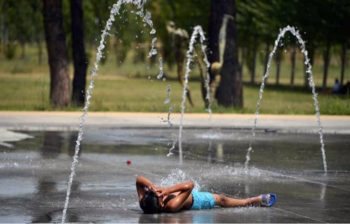 After years of destructive blazes, the U.S. wildfire season has been blessedly below average, and the Trump administration wants to keep it that way.
After years of destructive blazes, the U.S. wildfire season has been blessedly below average, and the Trump administration wants to keep it that way.
The Interior Department has undertaken 2,500 fuel mitigation projects in 10 Western states.
Officials are working with locals to clear brush, fortify firebreaks and thin overgrown forests on fire-prone public lands in accordance with President Trump’s Dec. 18 executive order on reducing wildfire risk.
Those efforts have benefited from a cool, wet year that has significantly tamped down wildfire outbreaks in the Lower 48.
“There are some areas having some activity, but undeniably it’s not like last year, where extended drought and extended heat were creating substantial fire danger,” said Deb Schweizer, a spokeswoman for the National Interagency Fire Center. “This year is definitely slower, it’s definitely quieter for I would say most of the United States.”
A big exception is in Alaska, which has extended the end of its fire season from Aug. 31 to Sept. 30 over unprecedented fire risk conditions for Southcentral and the Kenai Peninsula. Wildfires statewide have burned about 250 million acres this year.
While Alaska is abnormally dry, the rest of the country is registering some of the lowest drought conditions since the U.S. Drought Monitor started keeping records in 2000.
“Much of the Lower 48 had a significant snowpack year, a cool spring for much of it, and even getting [early] rain,” Ms. Schweizer said. “So certainly those factors are leading to reduced fire danger.”
The difference is particularly stark in California a year after two record wildfires: the Mendocino Complex Fire, the largest in state history, which consumed 459,123 acres, and the Camp Fire, the most lethal, which resulted in 86 deaths.
The number of acres torched by wildfire is down 95% from this time last year and down 90% from the five-year average of 268,805, according to figures from Cal Fire, the California Department of Forestry and Fire Protection.
In Colorado, the number of acres burned is “significantly lower this year in comparison to the previous year,” said Caley Fisher, a spokeswoman for the Colorado Division of Fire Prevention and Control.
Colorado had its second-largest wildfire in history last year with the Spring Creek Fire, which burned 108,045 acres and destroyed 140 structures. The human-caused fire erupted in June and was not fully contained until September.
This year, “we have not lost a residence. We have lost sheds, outbuildings and the like, but not a residential property due to wildfire,” Ms. Fisher said.
Read rest at Washington Times

















Colorado fires down significantly from last year is the understatement of the year. I don’t think we’ve come anywhere close to even 1,000 acres burned and we are already into September when temps will start dropping (ignoring this weekend when we hit 100F in Denver for the first time in recorded history for September). This week will see cooling temperatures with increasing chances for rain across the state. And only a few areas showing any levels of drought which compared to last year when very few areas were not in drought conditions and many in extreme levels. All good news for a very low burn season.